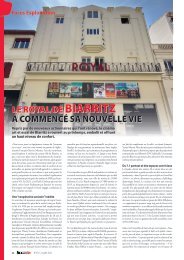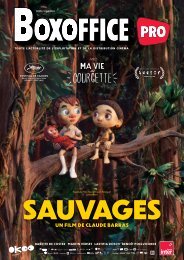Boxoffice Pro - Winter 2020
Boxoffice Pro is the official publication of the National Association of Theatre Owners
Boxoffice Pro is the official publication of the National Association of Theatre Owners
Create successful ePaper yourself
Turn your PDF publications into a flip-book with our unique Google optimized e-Paper software.
you would have said Miami; Chicago;<br />
Texas, in particular Houston, parts of<br />
Dallas and San Antonio; and obviously<br />
California. Maybe some of Colorado and<br />
Arizona. That was the case 20 years ago.<br />
Now you talk about Hispanic populations<br />
in Kansas City, St. Louis, and Minnesota.<br />
There is more representation in Colorado<br />
and Nebraska.<br />
In Milwaukee, Wisconsin, when I first<br />
joined the company over seven years<br />
ago, it was a movement that was starting<br />
to happen. I’m also the chairman of the<br />
Hispanic Collaborative in Milwaukee, and<br />
we do a lot of research on this. Over the<br />
past decade. the reason the entire state of<br />
Wisconsin has shown a population growth<br />
is thanks to Hispanics. If not for Hispanics,<br />
there would have been a declining<br />
population in the entire state. It is the most<br />
rapidly growing population base in the<br />
state of Wisconsin, in Milwaukee, and in<br />
the southern portions of Wisconsin.<br />
The importance of that, from a business<br />
perspective, is about consumerism and<br />
the workforce. It’s also represented in<br />
the age group—Hispanics and Latinos<br />
happen to represent the youngest average<br />
age in America. We happen to represent<br />
the highest percentage of millennials, the<br />
highest percentage of Gen Zers.<br />
This is not to discount all the other<br />
diverse populations, by any means. Asian<br />
communities are growing, so are African<br />
Americans and Black communities.<br />
Hispanics just happen to be growing at<br />
the fastest rate and are the largest ethnic<br />
minority in the entire United States.<br />
Minorities and underrepresented<br />
groups in the United States aren’t<br />
monolithic audience blocks that only<br />
go to movies that represent them.<br />
Hispanic audiences buying one in<br />
every four tickets sold at U.S. cinemas<br />
last year confirms that. When we start<br />
talking about bringing audiences<br />
back to the cinema during this very<br />
difficult recovery effort, how should<br />
we approach our outreach to Hispanic<br />
audiences?<br />
When you think about marketing to<br />
Hispanics, the fact that we ended Hispanic<br />
Heritage Month—and I know that there<br />
are a lot of other topics currently going on<br />
in the world—but how much discussion<br />
did you see, on any level in the media,<br />
of Hispanic Heritage Month? Very<br />
little to none. We missed a tremendous<br />
opportunity, at a time when we’re talking<br />
a lot about diversity and inclusion; we still<br />
managed to miss this particular gap.<br />
I’m Cuban American, born in Cuba,<br />
and grew up watching movies from across<br />
the world. The movies I couldn’t watch<br />
were actually from the United States—<br />
they were blacked out. I grew up watching<br />
Chinese, Japanese, Canadian, German,<br />
Spanish films, films from Mexico, from<br />
South America. For me, the beauty of our<br />
industry and what we represent is that we<br />
provide an education and other views of<br />
cultures that you wouldn’t otherwise get<br />
without traveling.<br />
We have an incredible richness as<br />
an industry. How do we relate that to a<br />
consumer base that appreciates it? When I<br />
think about my own background, growing<br />
up in Cuba, I love the movies because my<br />
parents and I went every Sunday. Every<br />
Sunday, that was our outing. No matter<br />
what, we went to the movies as a family<br />
on Sundays.<br />
We have an incredible audience base<br />
that is very loyal to our product. It’s an<br />
audience base that really relates to brand<br />
loyalty and brands that actually represent<br />
them well and recognize them. When you<br />
recognize Hispanics within your product,<br />
it helps make sure that they stay loyal to<br />
you and keep coming back.<br />
Part of that is reinforcing moviegoing<br />
habits that already exist. In Latin<br />
America, it’s customary to have a<br />
discount day in the middle of the week.<br />
When you came back to exhibition<br />
with Marcus Theatres in 2013, just as<br />
the country was recovering from a<br />
recession, the circuit introduced a<br />
discount day, $5 Tuesdays. Did you<br />
see a different sort of engagement<br />
after putting practices in place that<br />
Hispanic audiences might have<br />
already been familiar with?<br />
We introduced that concept just slightly<br />
over seven years ago as a $5 Tuesday,<br />
with free popcorn. We wanted our studio<br />
partners to recognize that we were putting<br />
skin in the game as well. Seven years<br />
ago, there were still economic challenges<br />
… it was very well accepted, almost<br />
immediately.<br />
The thing that most impacted me, both<br />
personally and professionally, was figuring<br />
out very quickly that we found an audience<br />
we had lost. Many of those audiences are<br />
diverse, from underserved communities<br />
with limited income to take their families<br />
out for any form of entertainment. All of a<br />
sudden, I’m getting letters and calls from<br />
moms saying, “Thank you, I’m now able to<br />
take my family to the movies, and thank<br />
you for the popcorn.” It felt like the right<br />
thing to do: reintroducing ourselves to<br />
communities that were now able to take<br />
their families out for a fun evening, while<br />
at the same time creating a very exciting<br />
day that does a lot of business.<br />
Especially right now, as we’re facing<br />
a very difficult part of the reopening<br />
phase, an initial reopening cycle with a<br />
lot of changes, a lot of things outside our<br />
control. At the heart of this challenge is<br />
reconnecting with a lost audience. Once<br />
you engage with these conversations<br />
around diversity, around inclusivity, you<br />
can apply the lessons in a number of<br />
different scenarios, including the current<br />
Covid recovery.<br />
As we talk about diversity and inclusion,<br />
about Hispanic Heritage Month, and the<br />
importance of diverse audiences, we need<br />
to remember we also provide an escape<br />
for people. What NATO has done through<br />
CinemaSafe, what every one of our theater<br />
chains has done, we’ve all spent a great<br />
deal of time in our planning, upgrading<br />
our systems and processes to make<br />
sure that people understand the safety<br />
procedures. Keeping in mind the health<br />
and safety of not only our customers but<br />
our associates. There isn’t a case that can<br />
be traced to any theater at this point in<br />
time. It’s important for us to get things<br />
started again.<br />
And there’s a bigger picture here:<br />
There’s an underserved community out<br />
there that is struggling economically<br />
without an outlet for out-of-home<br />
entertainment. Our communities, all of<br />
our consumers out there, are looking for<br />
a place to smile, have a healthy laugh, or<br />
a healthy cry. We provide that. I think it’s<br />
incumbent on government officials, on<br />
our film and distribution partners, and<br />
it’s incumbent on us in exhibition, to<br />
ensure that we work together. We need<br />
to make sure that this incredible art<br />
form continues to serve all communities,<br />
including diverse ones, so we can stay in<br />
business and continue to cater to them.<br />
We have a lot of work to do, and hopefully<br />
we can get started tackling it in a short<br />
period of time.<br />
<strong>Winter</strong> <strong>2020</strong><br />
23

















